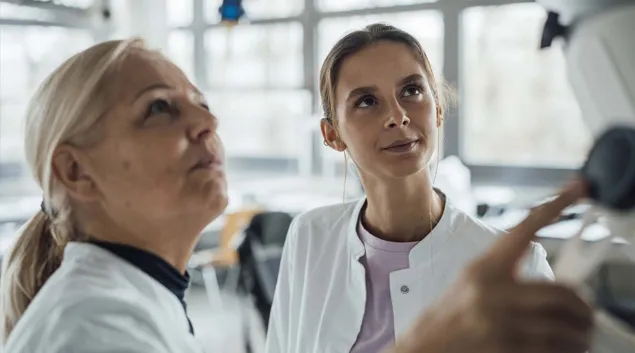
Photo: Westend61/Getty Images
A generative artificial intelligence system developed in-house at Northwestern Medicine is boosting productivity by identifying life-threatening conditions in milliseconds.
This could help with a global shortage of radiologists, according to a new study in JAMA Network Open.
The AI system was deployed in real time across the 11-hospital Northwestern Medicine network, where nearly 24,000 radiology reports were analyzed over a five-month period in 2024. Dr. Mozziyar Etemadi and his team then compared radiograph report creation times and clinical accuracy with and without the AI tool. Etemadi is an assistant professor of anesthesiology at Northwestern University Feinberg School of Medicine and of biomedical engineering at Northwestern's McCormick School of Engineering.
The results found an average 15.5% boost in radiograph report completion efficiency – with some radiologists achieving gains as high as 40% – without compromising accuracy.
Follow-up work showed up to 80% efficiency gains and enabled the tool for CT scans. The time saved allowed radiologists to return diagnoses much faster, particularly in critical cases, authors said.
They added this is the first generative AI radiology tool in the world to be integrated into a clinical workflow. It's also the first time a generative AI model has demonstrated both high accuracy and increased efficiency across all types of X-rays, from skulls to toes.
WHAT'S THE IMPACT
Unlike other AI models that focus on detecting a single condition, Northwestern's model analyzes the entire X-ray or CT scan. It then automatically generates a report that is 95% complete and personalized to each patient, in the radiologist's own reporting style, which the radiologist can choose to use, review and finalize.
These reports summarize key findings and offer a template to augment the radiologists' diagnosis and treatment.
In addition to improving efficiency, the AI system flags life-threatening conditions like pneumothorax (collapsed lung) in real time, before a radiologist looks at the X-rays. As the AI model drafts reports for every image, an automated tool monitors those reports for critical findings and cross-checks them with patient records. If the system identifies a new condition that needs urgent intervention, it could immediately alert radiologists.
The Northwestern team also is adapting the AI model to detect potentially missed or delayed diagnoses, such as early-stage lung cancer.
Meanwhile, authors cited data showing the U.S. expects a shortage of up to 42,000 radiologists by 2033, with imaging volumes rising 5% annually while radiology positions increase just 2%.
The AI tool can help radiologists clear backlogs and deliver results in hours, not days, authors said.
THE LARGER TREND
The use of artificial intelligence in healthcare is gaining popularity among physicians, finds a January survey from the American Medical Association, though many remain guarded in their enthusiasm due to lingering concerns.
About 35% of physicians expressed more enthusiasm than concern – up from the 30% who felt the same last year. The portion of physicians whose concerns exceeded their enthusiasm for health AI decreased to 25% in 2024 from 29% in 2023, and about two in five physicians remain equally excited and concerned about health AI, with almost no change between 2023 and 2024.
In particular, physicians are increasingly intrigued by AI's power as a clinical assistant, and in its potential to reduce administrative burdens, enhance diagnostic accuracy and personalize treatments.
More than half of health system leaders and insurance executives are calling artificial intelligence an "immediate priority," and 73% of organizations said they were growing their financial commitments to the technology, according to a November Define Ventures survey.
Seventy-three percent of organizations have established governance structures, which can align AI incentives with organizational values.
Jeff Lagasse is editor of Healthcare Finance News.
Email: jlagasse@himss.org
Healthcare Finance News is a HIMSS Media publication.